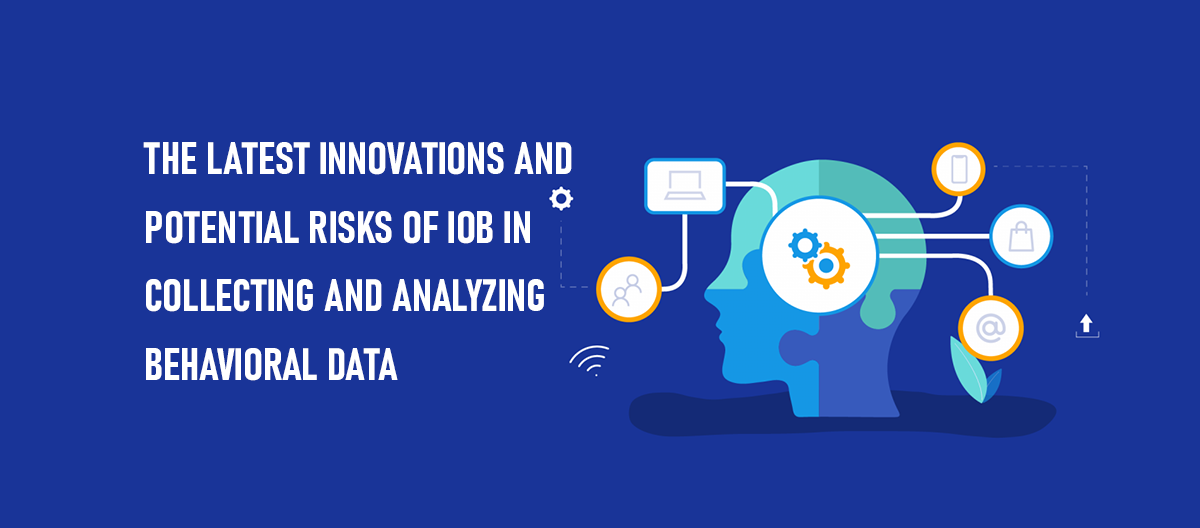The Latest Innovations and Potential Risks of IoB in Collecting and Analyzing Behavioral Data

Data Scientist
Deep learning and machine learning specialist, well-versed with experience in Cloud infrastructure, Block-chain technologies, and Big Data solutions.
June 05, 2023

Internet of Behaviours (IoB) is a group of research and development (R&D) that aims to understand the way people make purchases based on technology, when they make them, and why they do so. Among the disciplines that make up IoB are internet of things (IoT), edge analytics, and behavioral science. Several different types of IoB platforms are available to collect, combine, and analyze data collected from multiple sources, such as wearable computers, digital home devices, and online activities. As the information is analyzed through the lens of behavioral psychology, the marketing and sales teams can find trends that will help them shape future consumer behavior. The IoB aims to enable marketers to monetize the massive amount of data generated by network nodes in the Internet of Things. This technology is one of the trending technologies in the digital era, but it also has some drawbacks.
Benefits of IoB
Businesses have long tried to comprehend how people behave to be more effective and provide goods and services that people will use or like. In order to better understand human ideas, behaviors, and behavioral patterns, the Internet of Behaviour (IoB) concept has emerged, and it draws on concepts from various fields and technological advancements. The Internet of Behaviors presents a fantastic opportunity for the healthcare industry to create individualized experiences. The health apps that monitor a user's nutrition, sleeping habits, heart rate, and blood sugar levels might recommend behavioral changes. Based on the information gathered by smart devices, IoB apps can warn users of potential health issues, remind them to take their medications and prevent them from engaging in specific activities. The financial and insurance sectors are other industries where IoB has vast potential to change people's behavior for the betterment of safety and cost-savings. The IoB applications can help track financial activity to determine interest rates and credit scores. In order to maintain strong credit scores and obtain better borrowing rates, the IoB systems can identify behavior influences.
The Internet of Behaviors presents a fantastic opportunity for the healthcare industry to create individualized experiences. The health apps that monitor a user's nutrition, sleeping habits, heart rate, and blood sugar levels might recommend behavioral changes. Based on the information gathered by smart devices, IoB apps can warn users of potential health issues, remind them to take their medications, and prevent them from engaging in specific activities. The financial and insurance sectors are other industries where IoB has vast potential to change people's behavior for the betterment of safety and cost-savings. The IoB applications can help track financial activity to determine interest rates and credit scores. In order to maintain strong credit scores and obtain better borrowing rates, the IoB systems can identify behavior influences.
The IoB has the potential to become a fundamental technology idea for creating and selling what a user requires or a customer wants, which would result in substantial commercial innovation. However, the absence of structure and legality makes integrating IoB into daily life challenging. IoB represents a significant leap into the future, so organizations should prioritize addressing data privacy issues.
Internet of Behaviour Challenges and Potential Drawbacks
Companies and organizations that successfully navigate the difficulties of establishing and maintaining an IoB system might benefit from its benefits. Gathering private information from customers and employees will be the biggest challenge to success. There are a number of reasons why people give up some personal information, including ease of use and other benefits.
Even more private information is required by the IoB, such as invasive physical information that gauges both external and internal bodily functioning. Businesses will need to put in place a strict data collecting and privacy strategy supported by IoB technology that offers customers value—without making them feel invaded.
The following three issues confront IoB technology:
Regulations: Data privacy has become a crucial political issue in many jurisdictions, particularly in the wake of catastrophic data breaches at sites like Facebook, Yahoo, and LinkedIn that rely on user data. IoB systems and devices will need to be designed by businesses to adhere to many jurisdictions' legal requirements. In circumstances where data collection is constrained, an IoB system may even need to disable some functions.
Value: In return for their personal data being given up, people desire better goods and services, exceptional customer experiences, and an increased standard of living. IoB data may contain particularly sensitive information. Thus, the benefit to the customer must outweigh the risk.
Safety: IoB technology is another potential attack vector for thieves to use, similar to IoT devices.
IoB Increases the Importance of Data Security
The fuel that powers IoB innovation will be behavioral data sources such as biometric data, location data, health data, buying patterns, etc. However, this kind of information can also be used maliciously for things like identity theft, stalking, and extortion for cash. IoB data offers criminals opportunities in a manner similar to how it can help customers and businesses.
Using behavioral information acquired through the IoB could make phishing efforts more sophisticated. Victims may be the target of fraud, extortion, or other nefarious schemes. Organizations can employ IoB systems to impose political or social control over populations by leveraging the Internet of Behavior as a manipulative or coercive weapon.
Internet of Behaviour in the Future
IoB health apps for cell phones, including SoberTool, Noom, SmokeFree, and HealtpSync, support diabetes management through blood glucose and activity tracking. Regardless of worries about data privacy, these IoB apps and systems will continue to spread.
Most people will also be at ease supplying behavioral data, as seen by the popularity of social media sites, e-commerce, digital assistants, and other technologies that call for personal information. This opens the door for IoB to reimagine how businesses and organizations engage with and sway people through technology.
Importance of the Internet of Behaviour for Innovations
Internet of Behavior, or IoB, has been cited by Gather as one of the top trends for the next few years, 2021. By the end of 2025, they predicted that 40% of people worldwide would be subject to at least one IoB application. IoT data will improve user behavior and assist businesses in growing.
The Internet of Business is a significant boon to the sales industry. At the same time, for decades, businesses relied on data to make decisions. First and foremost, IoB focuses on gathering, analyzing, and comprehending user behavior in order to improve service quality and the value chain.
IoB devices function on four levels:
Computing hardware with limited or advanced capabilities
IoB devices have embedded software and sensors that measure human-generated data. It depends on the device's processing power whether sensor data should be stored on the device or in the cloud.
Networks that can be wireless or hybrid in nature.
Connectivity technologies enable IoB systems to securely exchange data at predefined intervals or in real-time with one another and a central hub.
Infrastructure on the back end
A wide range of solutions are available for storing, analyzing, and visualizing data. IoB's "infrastructure" team also refers to a system that makes sure a device continues to run smoothly, such as a group of healthcare professionals ready to respond to a personal help button.
End-user programs
Individuals should be able to configure IoB devices, link them to other gear and apps, and see sensor data over time. Although speech interfaces are gaining popularity in the Internet of Things domain, these apps are typically launched on mobile devices.
At this point, IoB data is primarily collected from external areas of our bodies via a smartwatch or fitness gadgets and analyzed in a central place by proprietary software developed by private corporations.
The significant risk of IoB
Security Threats
IoT devices are vulnerable to the same security problems as IoT devices or any other technology that keeps data in the cloud. Unauthorized parties could exploit vulnerabilities to disclose private data, tamper with data, or lock users out of their accounts. However, the stakes are quite high, given the nature of IoT devices and data.
The risk occurs not only at the individual level, but also at the national level. Some implanted medical devices may be susceptible to manipulation by hackers, which can cause physical harm or even death. National security is also an issue since any IoB-collected data could reveal sensitive information, such as the whereabouts of US service members.
Ethical Issues
Privacy and security problems are ethical issues for individuals whose data has been hacked. However, the IoB introduces other ethical considerations, such as injustice and challenges to human autonomy.
Conclusion
Some groups may miss out on the IoB's immediate benefits and long-term impact on public health programs if they do not have insurance, an internet connection, or a certain amount of tech-savvy. It is in its early stages, so there are fundamental disputes regarding who owns data and whether individuals should be able to opt out of collecting it. This something certainly has the potential to plunge us into a dismal future. In the end, it will no longer be the man who controls technology but the technology who controls man.













